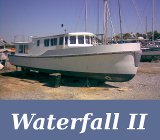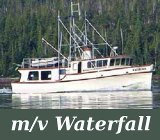

Building a Fiberglass Dinghy or Two
Components














The Components are defined as parts that are fiberglassed into the hull. These help stabilize the hull, it is pretty floppy without any support.
Seat plugs
Seat plugs
Seats will be integral with the boat, each air tight for buoyancy if the boat fills up with water. Not sure what the Coast Guard rules are on this but if you are building it for yourself this works great. No added weight of open cell foam poured into it.
Paint the seat plugs with enamel paint. Since these are plugs also and the insides will not be seen you do not have to be concerned with the smoothness. Paint on Partial and fiberglass. Matt, Roven, Roven, Matt
A set for each boat
For the seats to set where they are designed for, fiberglass some shelves. Here across the transom is a 2 x 4 ripped with a 15 degree angle, screwed to a couple pieces of thin plywood scraps and clamped to the transom. Do the same for all of the seats, of course the angles will be different. Wax the bottom side of the 2x4. Matt, Roven, Matt
Shelves in for the back seat. The piece along the bottom is to install the 1 inch pvc pipe tubes for the drains. Bed them in with resin/cabasil putty where they go through the hull and where they go through the transverse piece. Doing it this way makes it easier to fiberglass the seat along the bottom.
When putting in the putty do not make it too thick or it will get too hot and crack. Do it in a few lifts.
When putting in the putty do not make it too thick or it will get too hot and crack. Do it in a few lifts.
Bow seat shelves.
Strips over the runners. The reason for this is any small amounts of water will sit in the runners leaving the deck or bottom relatively dry. Fiberglass some strips and cut them so they fit at the top of the runners, then fiberglass over them.
The hull is 1/8 inch thick so for added support for the engine I fiberglassed a piece of boatboard in the transom. Matt, Roven, Roven Matt
With the back seat fiberglassed in, it gives support to the transom for the motor. This takes place of the plywood usually used. Plywood will eventually get wet and rot. No wood on these boats.
Fiberglass the edges to the hull, Matt Roven Roven Matt
On this seat and the front seat you can see some strenghteners . They are 1 inch pvc pipe fiberglassed onto the bottom of the seats.
On the completed boat I drilled 3/8 inch holes in each back corner of the seats so you are not sitting in a puddle of water.
Fiberglass the edges to the hull, Matt Roven Roven Matt
On this seat and the front seat you can see some strenghteners . They are 1 inch pvc pipe fiberglassed onto the bottom of the seats.
On the completed boat I drilled 3/8 inch holes in each back corner of the seats so you are not sitting in a puddle of water.
Front seat fiberglassed in. Since the seat was set on the shelves and where it meets the bottom is flat across the pieces covering the runners, the runners are open to the seat and therefore the seat is not water tight. To fix that I drilled small holes in the runner covers just below where the front seat is fiberglassed in and shot some expanding foam into the runners to make the seat watertight. Then put a piece of fiberglass over the hole.
The center seat fiberglassed into the hull. This is an extra heavy layup on the top of the seat since there is a lot of weight there when the boat is tipped up on its side.
Grind the entire inside of the boat to the desired smoothness. At this point it is up to you how smooth a finish you want. Grind and fill with resin/cabasil until it is as smooth as you like. Be carefull not to grind into the fiberglass and weaken it.
When locating these strengtheners keep in mind where the compartment access plates are going to be installed. See the 'outfitting' page for these locations.






